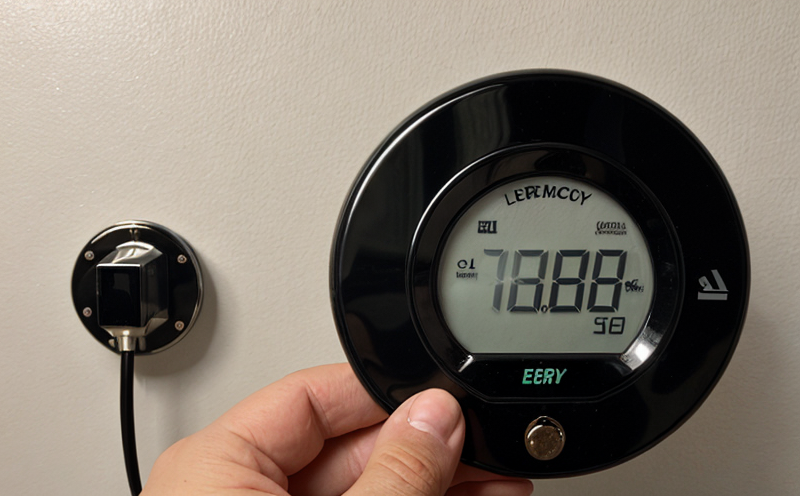IEEE 112 Energy Efficiency Testing for Electric Motors
The IEEE Standard 112-2017 specifies methods of measuring and calculating the energy efficiency of electric motors. This service is critical for ensuring compliance with international standards and regulations that aim to reduce energy consumption and improve sustainability in industrial settings.
Energy efficiency testing is a cornerstone of modern manufacturing and industrial operations, particularly in sectors such as automotive, aerospace, and renewable energy. By accurately measuring the power input and output of electric motors, this testing helps manufacturers identify inefficiencies and optimize performance. The IEEE 112 standard provides a standardized approach to these tests, ensuring that results are reliable and comparable across different motors and manufacturers.
The testing process typically involves several key steps:
- Identification of the motor type and its operating conditions
- Setting up the test environment according to ISO 8920 standards for electric motors
- Measuring power input using a wattmeter
- Determining torque output through sensor calibration
- Capturing data over a range of load conditions to ensure comprehensive analysis
The results are then analyzed and compared against the specifications outlined in IEEE 112. Compliance with this standard ensures that motors meet or exceed energy efficiency targets, thereby reducing operational costs and environmental impact.
For quality managers and compliance officers, this testing is essential for maintaining regulatory adherence. In R&D environments, it provides valuable insights into motor design improvements. For procurement teams, it helps in selecting suppliers who adhere to high standards of energy efficiency.
The importance of IEEE 112 testing cannot be overstated. It plays a pivotal role in reducing energy consumption across various industries, contributing to global efforts towards sustainability and environmental stewardship.
In the next section, we will explore why this type of testing is critical for various stakeholders within your organization.
Why It Matters
Energy efficiency testing, particularly in electric motors, has far-reaching implications across multiple sectors. For quality managers and compliance officers, ensuring that all products comply with international standards is a top priority. This not only helps in maintaining a good reputation but also ensures legal compliance.
R&D engineers benefit from such tests as they provide detailed insights into the performance of motors under different conditions. By identifying inefficiencies early on, these professionals can innovate and develop more efficient motor designs. Procurement teams, meanwhile, use these test results to select suppliers who meet stringent energy efficiency criteria, thus reducing overall operational costs.
The environmental impact of non-compliant products cannot be ignored either. Improving the energy efficiency of electric motors has a direct effect on reducing carbon footprints and promoting sustainable practices. In an era where sustainability is increasingly being prioritized by consumers and governments alike, this testing becomes even more crucial.
Moreover, compliance with standards like IEEE 112 helps businesses stay ahead in competitive markets. It signals to potential customers that your products meet the highest quality standards, thereby enhancing brand loyalty and customer satisfaction.
In summary, energy efficiency testing is not just about meeting regulations; it's a strategic investment in future-proofing your business. By staying compliant with these standards, you contribute to a greener planet while also safeguarding your competitive edge.
Scope and Methodology
The scope of IEEE 112-2017 encompasses the measurement and calculation of energy efficiency for single-phase, three-phase, synchronous, and asynchronous electric motors. The standard specifies detailed procedures for conducting these tests, including the setup of test equipment, the application of load conditions, and the recording of data.
The methodology involves several key steps:
- Identification of motor type and relevant standards
- Setting up the test environment to ensure accurate measurements
- Application of specified load conditions for different operating points
- Measurement of power input using precision instrumentation
- Determination of torque output through calibrated sensors
- Data collection over a range of operating conditions
The test setup must adhere to the requirements specified in ISO 8920 and ASTM D341 for electric motors. This ensures that all measurements are accurate and reproducible, which is crucial for ensuring compliance with IEEE standards.
Once the data has been collected, it is analyzed using statistical methods to determine the efficiency of the motor under different load conditions. The results are then compared against the specifications outlined in IEEE 112-2017. Compliance with these standards ensures that motors meet or exceed energy efficiency targets.
This comprehensive approach guarantees reliable and consistent test results, which is essential for maintaining high-quality products and ensuring compliance with international regulations.
Environmental and Sustainability Contributions
The importance of energy efficiency testing in electric motors cannot be overstated. By accurately measuring the energy consumption of these devices, we can identify inefficiencies and optimize performance, leading to significant reductions in operational costs and environmental impact.
In recent years, there has been a growing emphasis on sustainability across all industries. The manufacturing sector, which heavily relies on electric motors for production processes, plays a crucial role in this effort. By improving the energy efficiency of these motors, we can reduce greenhouse gas emissions and conserve natural resources.
According to recent studies, optimizing motor efficiency can lead to reductions in electricity consumption ranging from 10% to 30%. This not only translates into substantial savings for businesses but also contributes positively to global sustainability goals. For instance, the European Union's Green Deal aims to reduce carbon dioxide emissions by at least 55% by 2030, and improving motor efficiency is a key component of this initiative.
From an environmental perspective, the reduction in energy consumption translates directly into lower carbon footprints. By choosing motors that meet IEEE standards, organizations can significantly contribute to the fight against climate change. This aligns with broader sustainability efforts such as ISO 14001 and LEED certifications, which emphasize reducing waste and conserving resources.
In conclusion, energy efficiency testing for electric motors is not just a technical requirement; it's a strategic investment in sustainable development. By ensuring compliance with IEEE standards, businesses can play their part in creating a greener future while also enhancing operational efficiency and cost-effectiveness.





